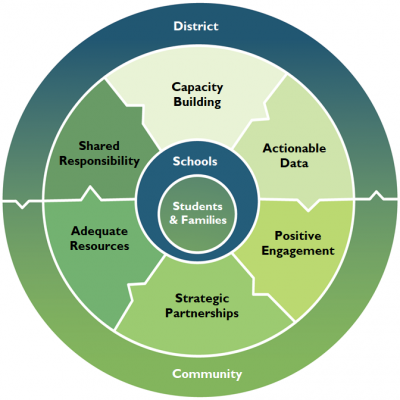Key Ingredients for Systemic Change
Take a Data Driven Systemic Approach
As the graphic below shows, improving attendance is a team not a solo sport and ultimately requires a systemic approach. Our experience working across the country tells us that while attendance improvements can begin in a single classroom or school, the most effective and sustainable approaches are data-driven, and are supported by strong district, school and community leadership. These key ingredients of change support taking a systems approach, and can be applied to district and state-level action and policy – which are ideally working in alignment with each other.
Click on the graphic below to enlarge.
Capacity Building
Provide professional development to district and school staff and community partners so they have the skills and knowledge they need to take a data-driven, positive, problem-solving and multi-tiered approach to supporting student attendance, participation and engagement.
Actionable Data
Collect and report quantitative attendance and chronic absence data and qualitative analysis that can show reasons that students miss school that are accurate, accessible, timely, comprehensive and understandable. These data will inform the development of prevention and intervention strategies and allocation of resources that support student attendance. The data collection is used to activate positive supports, not punitive action.
Positive Engagement
Create a culture of attendance by taking a positive, not punitive, approach to absenteeism that is centered on belonging and engagement, and help everyone to understand why daily attendance matters in PreK-12th grade.
Strategic Partnerships
Strengthen and expand partnerships between the district, school and community to provide for a full range of resources and supports to address barriers to attendance. Engage outside partners that can support building relationships and engaging students and families in identifying and addressing attendance barriers.
Adequate Resources
Resources and funding are sufficient to ensure students, from all backgrounds and circumstances, receive a quality education and similar opportunities to thrive and achieve in school, career and college.
Shared Responsibility
Absenteeism is a cross-cutting issue and cannot be solved by any one person, department or agency alone. As the graphic shows, everyone has a role to play to help students show up to school: students, families, schools, districts and partners in the community, ranging from non-profits to state agencies. Create systems and structures at the school, district and community levels for people to work together to improve student attendance. While formal accountability systems can hold districts and schools accountable, everyone can be responsible for helping to reduce chronic absence.
